The crispy and flaky Aloo Samosa makes for an ideal appetizer or snack at any festive gathering. Packed with a deliciously spicy potato filling, this samosa is also suitable for vegans!
With this easy and fail-proof samosa recipe, you can make the ultimate flaky and perfectly crispy aloo samosa in the comfort of your home.
Making your own cheeses allows you to create unique and personalized flavors.
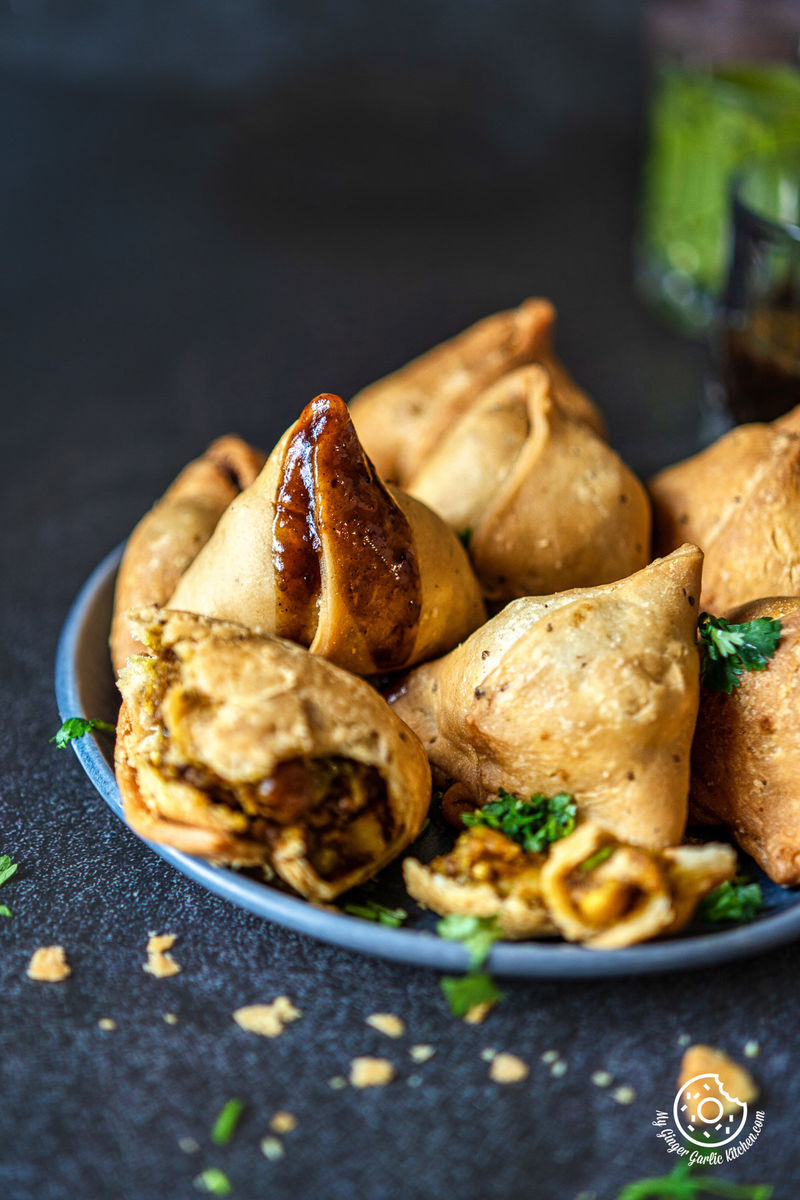
Table of contents
About Samosa
Samosa is an unbelievably delicious and popular pyramid-shaped snack originating from the Middle East. This indulgent snack made its way to India during the Delhi Sultanate era and soon became a favorite dish of Indian cuisine.
It is not only popular in India but also in many other countries around the world.
This mouth-watering triangle ‘Samosa’ is a delightful treat. They are flaky pastries filled with spiced potato, chicken, or lamb filling. Samosas rule the hearts and taste buds of Indians.
Samosa is a great hit at parties and gatherings, making it a crowd-pleasing choice for any occasion. The remarkable thing about this Vegan-Friendly Samosa is its versatility. It can be served as a vegan appetizer, a teatime snack with a hot cup of chai, or even as part of a larger Indian meal.
Making homemade samosas is a satisfying experience, and their crispy, flaky crust paired with the spiced potato filling is simply tantalizing.
Whether you are a novice cook or an experienced chef in Indian cuisine, this easy-to-follow samosa recipe will help you master the art of making perfect samosas.

The samosas made using this recipe have an amazingly crispy and flaky crust that is simply irresistible.
The aloo masala, also known as spiced potato filling, is infused with a delectable blend of aromatic Indian spices, giving each bite of this samosa a burst of authentic and rich Indian flavors.
The dough creates a crispy, flaky exterior, while the spiced potato filling provides a delightful and flavorful interior. When the dough and filling are combined, they create a great balance of textures and tastes, making samosas an irresistible treat.
So, roll up your sleeves, gather the ingredients, and get ready to enjoy the delightful journey of making this iconic Indian snack. Cooking samosas at home allows you to connect with the rich history and culture of Indian cuisine.
In this post, I will guide you through the process of making the perfect samosa from scratch.
This Samosa
✔︎ Is deliciously crispy
✔︎ Is simple and easy to make
✔︎ Is packed with rich Indian flavors
✔︎ Is vegan-friendly
✔︎ Can also be made gluten-free
✔︎ Is a wonderful teatime snack
✔︎ Is also suitable for parties or get-togethers
✔︎ Is an ultimate Party Favorite
✔︎ Is satisfying and comforting
✔︎ Is made from scratch

Ingredients
For the Samosa Dough
-
All-Purpose Flour: Maida or all-purpose flour is used to make the base of the samosa pastry dough. It provides structure and a crispy texture to the crust of the samosa.
-
Ajwain Seeds: Carom seeds or Ajwain seeds are added for a distinct flavor and enhanced aroma to the dough. They also aid in digestion.
-
Ghee or Oil: Samosas require some kind of fat (also known as ‘Moyan’). You can use either ghee (clarified butter) or oil to bind the dough and make it pliable. The addition of some kind of fat also contributes to the flakiness of the outer layer of the samosa.
-
Water: You will also need water to knead the samosa dough.
For the Spiced Potato Filling:
-
Oil: It is used for sautéing the spices and cooking the filling. You can use any neutral oil for making samosa filling.
-
Potatoes: Boiled, peeled, and mashed potatoes are the star ingredient of this aloo filling. They add a creamy, velvety, and hearty texture to the samosas.
-
Spices: To make the most delectable samosa filling, you will need a blend of aromatic whole spices, including cumin seeds and powder, coriander seeds, turmeric, garam masala powder, red chili powder, and amchur (mango powder), along with salt.
The collective blend of spices imparts bold, complex flavors to the filling.
-
Ginger: Some freshly crushed ginger is added to the filling for a zesty, warm, and slightly spicy kick.
-
Nuts & Dried Fruits: To give this filling a royal touch, you can also add some raisins and cashew nuts to the filling. However, adding cashew nuts and raisins is optional here.
-
Peas: Adding green peas to this recipe provides a burst of sweetness and a pop of color to the filling. Potatoes and peas blend perfectly well together. Adding green peas is optional, though.
-
Green Chilies: Finely chopped green chilies are added to the samosa filling for heat. Feel free to adjust the amount of green chilies based on your spice tolerance. If you don’t like a very spicy filling, then you can omit adding them.
-
Salt: It is an essential seasoning to enhance all the other flavors in the filling.
-
Asafetida (Hing): A pinch of hing or asafetida is added for a subtle umami flavor to the filling. It also aids in digestion.
-
Fresh Cilantro: Some freshly chopped cilantro leaves are added for herby freshness and a touch of greens to the filling.
Variations
Vegetable Samosa:
If you want to try a different filling, you can make vegetable samosas by adding a variety of vegetables like carrots, corn, cauliflower, and bell peppers to create a mixed vegetable samosa. This variation adds a pop of color and a medley of flavors to your samosas.
Paneer Samosa:
Love adding paneer to your dishes? Then you can add crumbled or grated paneer (Indian cottage cheese) to the potato filling. It makes it creamy and protein-rich. Paneer samosas are loved by paneer cheese enthusiasts. You can also use paneer bhurji as a filling.
Meat Samosa:
Meat samosas make a hearty and savory alternative to aloo samosa. For non-vegetarians, making meat samosa is a wonderful option. In this variation, you can replace the potato filling with spiced ground meat such as lamb, chicken, or beef.
Sweet Samosa:
If you want to explore a dessert samosa, then you can try a sweet samosa. Like mawa kachori, you can make the dessert filling using sweetened khoya (milk solids), nuts, and dried fruits. Simply fry these samosas and then dunk them in sugar syrup, and your sweet samosas are ready.
You can serve them as desserts during parties or festivals like Diwali or Holi.
Bean Samosa:
You can experiment with fusion fillings. If you like Mexican dishes, then you can make Mexican-inspired samosas with a bean filling made using black beans, corn, and spices. You can also use this bean filling, which I used as a tostada topping.
Baked Samosas:
For a healthier option, you can bake the samosas instead of deep-frying them. I have also shared a baked version of the samosa recipe on this page in the recipe card.
Spinach and Cheese Samosa:
Spinach and cheese make a great combination for savory dishes. Adding spinach and cheese is a fantastic way to add some greens and cheesy goodness to your snack. You can use this filling for a delightful fusion samosa.
Gluten-Free Samosa:
Use a gluten-free flour blend (such as rice flour or a gluten-free all-purpose flour) to make the dough if you have gluten sensitivities or allergies. Ensure that all other ingredients are also gluten-free.
Mini Samosas:
Mini bite-sized samosas make lovely snacks or appetizers for parties or other celebrations. You can make the samosa using the same aloo filling or use spicy dal filling for this.
You can also discover a world of innovation with samosas as we present a delightful array of creative recipes that will tantalize your taste buds. From the charming Samosa Pinwheels and the delectable Samosa Roll to the unexpected twist of a Baked Samosa with Chocolate Tamarind Chutney, and the fusion sensation of Samosa French Loaf accompanied by zesty Coriander Chutney.
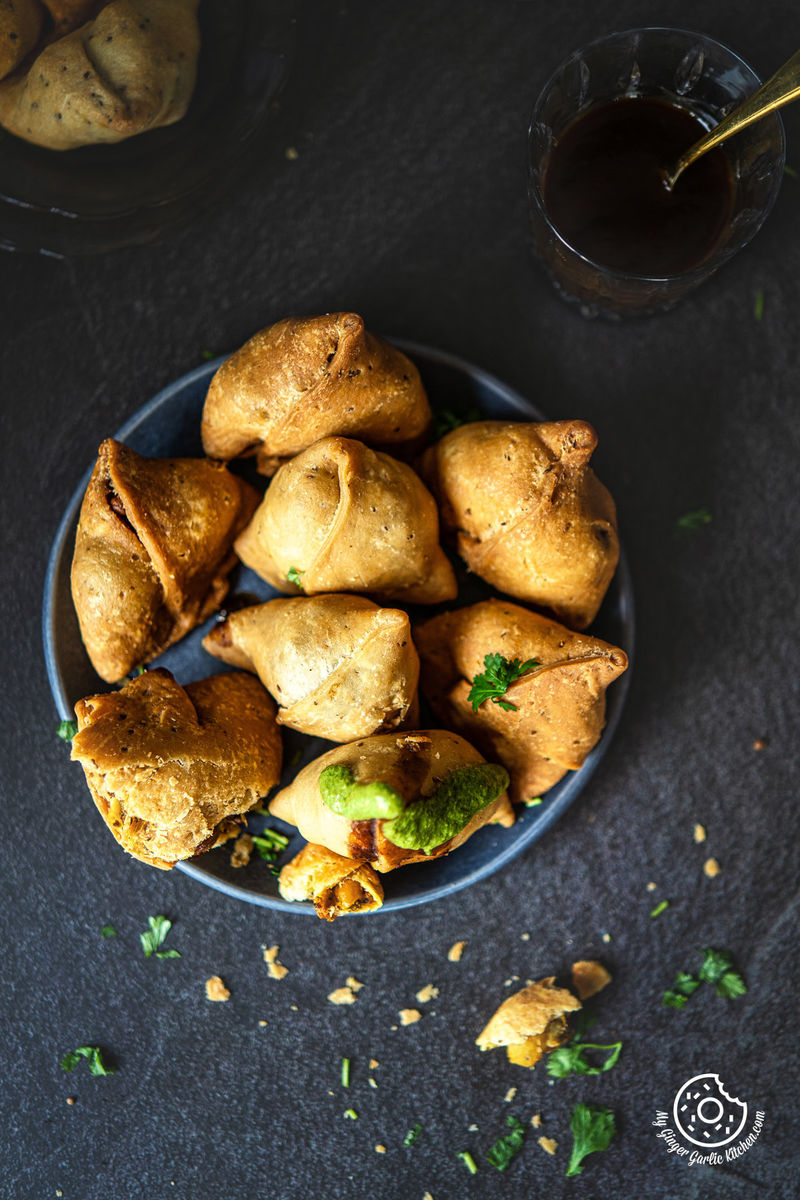
Serving Suggestions
Teatime:
Samosas are a wonderful tea-time snack. For the most exotic experience, serve them alongside a steaming cup of masala chai.
Chutney:
For a delightful combination of flavors, you can serve your samosas with some chutney and a cup of hot coffee, or chai. A variety of chutneys can be used for dipping and to balance the spicy flavors. Chutneys that pair well with samosa include green coriander (cilantro) chutney, mint coriander chutney, and sweet tamarind chutney.
Yogurt/Sabji:
You can also serve them along with a dollop of plain yogurt or boondi raita. For a spicier snack, serve them along with chana masala or aloo ki sabji.
Samosa Chaat:
Samosa chaat is a popular street food variation in India. If you love chaats, you can transform this enticing samosa into a chaat. To make samosa chaat, break the hot samosa into a shallow dish. Top it with chola masala, yogurt, tamarind chutney, green chutney, aloo bhujia or sev (crispy noodles), coriander leaves, and pomegranate arils. Sprinkle it with spices like chaat masala powder, red chili powder, and some more sev. Serve immediately!
Side Dish:
You can also serve them as part of a festive Indian thali consisting of other Indian dishes like palak paneer, paneer pasanda, restaurant-style dal tadka, garlic naan, palak puri, aloo gobi, matar pulao, onion tomato raita, papad, peach chutney, laccha onion, besan halwa, mango kalakand, and mango lassi.
Storage Suggestions
If you have leftover samosas, you can store them in an airtight container in the refrigerator for up to 2-3 days. Refrigeration helps keep them fresh and prevents them from turning soggy.
Reheating:
When you want to eat them, reheat them. You can reheat them in an oven or an air fryer until they are crisp again. While reheating samosas, avoid microwaving as it can make the crust soft.
Refrying Leftovers:
Alternatively, you can also reheat leftover samosas by deep-frying them for a few minutes until they regain their crispiness.
Freezing:
To store samosas for a longer period, freezing is a great option. To freeze, arrange the samosas on a freezer-safe tray and place them in the freezer until they harden. After that, transfer them to an airtight freezer-safe container or zip-lock bag.
These can be stored in the freezer for up to 2-3 months. Whenever you want to eat samosas, reheat them in a preheated oven or air fryer at 350°F (175°C) for 10 minutes or until they are heated through and crisp again.
For the best taste and texture, serve the reheated samosas while they are still warm.
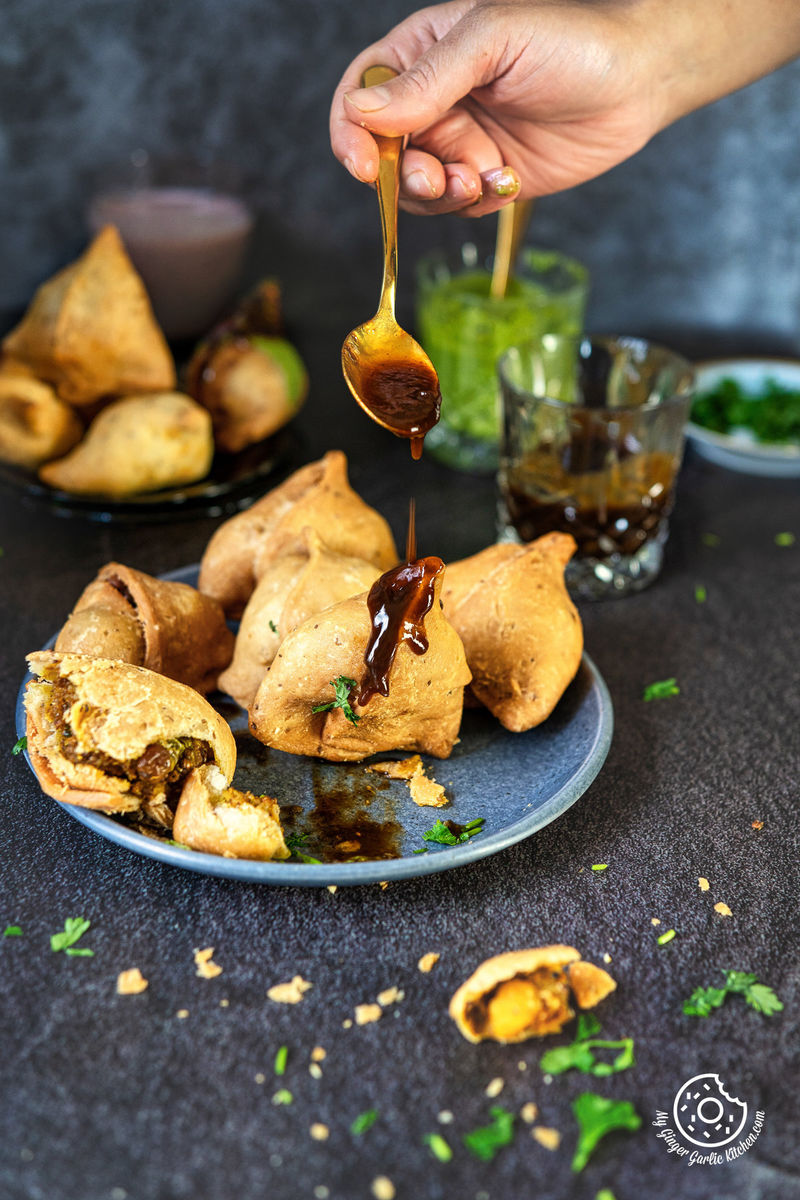
Important Tips and Tricks to Make the Best Samosa
Perfect Samosa Dough:
Ghee/Oil: When making samosas, use enough ‘moyan’ (ghee or oil) to achieve a flaky crust. A small amount of fat can make the crust hard, so use the recommended amount in this recipe for a crispier texture.
Dough: The dough should have a consistent texture for making samosas. It should neither be too soft nor too hard. You need to strike the right balance of moisture and stiffness in your dough. It should be pliable but not overly soft.
If your dough is too soft, add a bit more flour; if it’s too hard, add a touch more water while kneading.
Rest the Dough: It’s especially important to let the dough rest for at least 30 minutes. This step relaxes the gluten, making the dough easier to work with.
Rolling & Shaping:
Perfect Triangle: To create perfect triangles, roll out the dough evenly. This step ensures that each samosa has a uniform thickness and cooks evenly.
Proper Sealing: Seal the edges of the samosa triangles tightly using water to prevent the filling from leaking out during frying.
Avoid Overstuffing: When shaping samosas, be cautious not to overfill them. Overfilling can lead to difficulty sealing and bursting during frying.
Frying:
Oil Temperature: Maintain the oil temperature at the right level before frying. Keep the oil at a steady medium heat. To check if the oil is hot enough, drop a small piece of dough into the oil. If it sizzles and rises to the surface, the oil is ready.
Oil that is too hot can brown the samosa too quickly without cooking it through, while oil that is not hot enough can result in excessive oil absorption.
Even Frying: Fry the samosas over medium heat to ensure even cooking and achieve a beautiful golden hue. To maintain a consistent oil temperature while frying, rotate the samosas often.
Drain Excess Oil: Use a slotted spoon or spider strainer to gently remove the samosas from the hot oil to prevent splattering. Place the fried samosas on a paper towel-lined plate to remove any excess oil.
Double-Fry Method: For an exceptionally crispy crust, consider double-frying your samosas, similar to how French fries are prepared. First, fry them at a slightly lower temperature, let them cool, and then re-fry them at a higher temperature until golden brown.
Serving:
Pairing: Samosas taste best when served immediately, especially alongside a hot beverage like chai. Chai and samosas make a perfect combination, enhancing tea time.
Make Ahead: If you plan to serve samosas at parties or want to enjoy them later, you can prepare them in advance and keep them covered in the refrigerator for up to 3 days. When you’re ready to serve, simply deep-fry them.
Freezable: You can make a large batch of samosas and freeze them for later use. When you want to fry them, you can do so directly from the freezer or after thawing them overnight in the refrigerator.
Filling:
Spiced Potato Filling: The filling prepared here is a Halwai-style samosa filling. If you prefer a different flavor profile, feel free to use your preferred spices to adjust the filling to your taste.
Cool Filling: Allow the potato filling to cool completely before stuffing it into the samosas. Using hot filling can lead to dough tearing and sogginess.
Potatoes: For the samosa filling, you can either use roughly mashed potatoes with some large chunks for added texture or use smooth mashed potatoes for a creamier texture.
Experiment with Filling: Get creative with your filling. Explore different combinations of vegetables, meats, nuts, or lentils to suit your taste.
Customization:
Vegan Samosas: Samosas are entirely vegan-friendly when you use oil for making the pastry dough. To ensure that your samosas are vegan, use oil or vegan ghee for the dough.
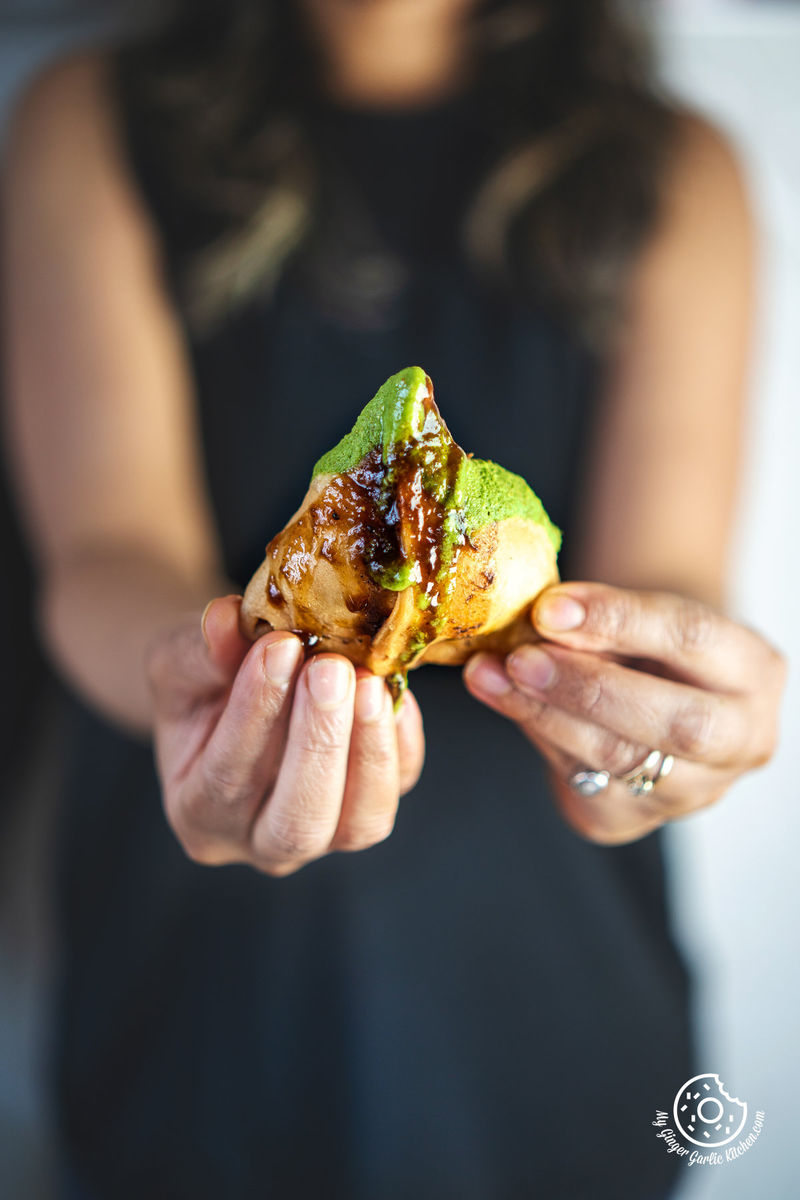
FAQ
What is a samosa?
A samosa is a popular and delicious Indian snack enjoyed as an appetizer or tea-time snack. It features a crispy, flaky pastry shell filled with spiced potato or meat mixture. Samosas can be deep-fried, air-fried, or baked and are a beloved snack.
What is the history of samosas?
Samosas have a rich history, with origins dating back to the Delhi Sultanate rule in India. They were influenced by the Middle Eastern dish “sambusak” and later evolved into the popular snack known as ‘samosa.’
How do I make the samosa dough crispy and flaky?
To achieve a crispy and flaky samosa crust, use enough ghee or oil when making the dough, and allow the dough to rest for at least 30 minutes.
Can I make samosas ahead of time?
Yes, you can prepare samosas in advance. Simply make the samosas and freeze them. When you’re ready to enjoy them, you can fry or bake them directly from the freezer.
What can I serve with samosas?
Samosas are typically served with coriander (cilantro) chutney and sweet tamarind chutney. They can also be enjoyed with a cup of chai, as part of a chaat dish, or alongside other Indian dishes.
How do I reheat leftover samosas?
To reheat leftover samosas, preheat your oven or air fryer to 350°F (175°C) and bake/air-fry them for about 10-15 minutes until they become crispy again.
Can I bake samosas instead of frying them?
Yes, you can bake samosas for a healthier option. Brush them with a little oil and bake them in a preheated oven at 350°F (175°C) until they turn golden brown and crisp.
Can I bake samosas instead of frying them?
Yes, you can air-fry samosas for a healthier alternative. I have given the step-by-step picture recipe and video instructions on this page. You can find the air-fryer samosa recipe on the recipe card.
Can I make gluten-free samosas?
Yes, you can make gluten-free samosas by using gluten-free all-purpose flour or rice flour for the dough and ensuring all other ingredients are gluten-free.
Are samosas always vegetarian?
Samosas can be both vegetarian and non-vegetarian, depending on the filling. Classic samosas like this recipe have a vegetarian potato filling, but there are also meat-filled variations.
Samosa Recipe (Step-by-step photo instructions)
For the Samosa Dough:
- In a mixing bowl, combine the all-purpose flour, carom seeds (ajwain), salt, and ghee (or oil). Mix the ingredients well until the mixture resembles breadcrumbs. To check, take some flour mixture between your palm and make a fist. If it holds the shape, then you have added enough fat. If the dough falls to pieces, that means you need to add more oil/ghee. Gradually add water and knead the mixture into a firm, smooth dough. Cover it with a cloth and let it rest for 30 minutes.
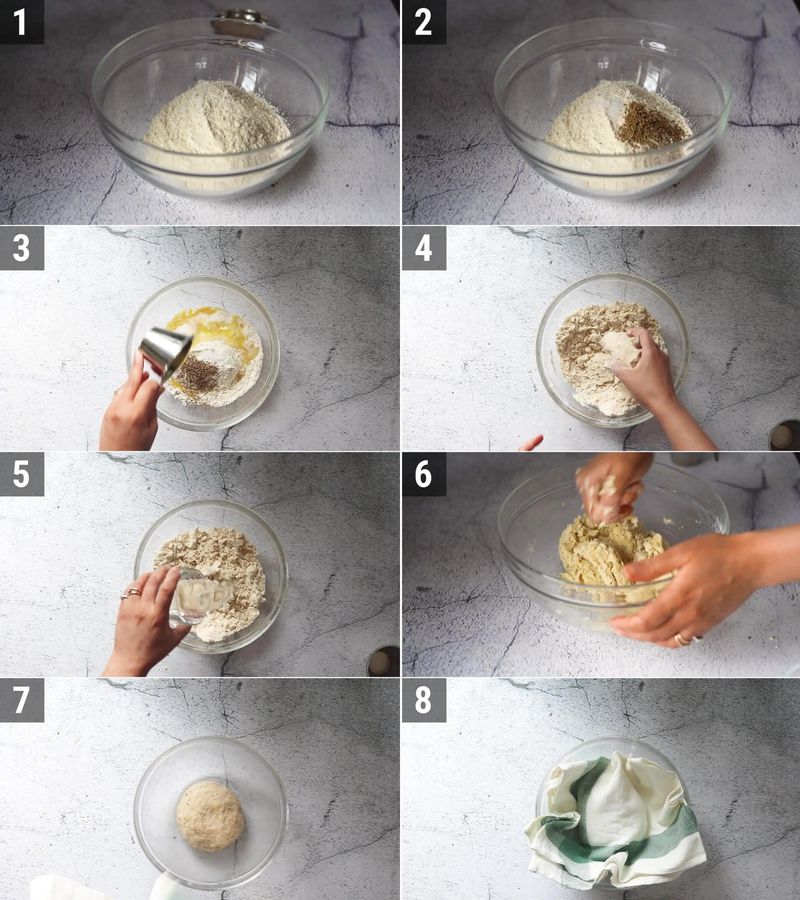
For the Spiced Potato Filling:
- Using a potato masher, mash the boiled and peeled potatoes. Keep them aside. Heat oil in a pan on medium heat. Add the coarsely pounded coriander seeds, fennel seeds, crushed cloves, cumin seeds chopped cashews, and raisins. Sauté until they turn fragrant and golden brown. Next, add grated ginger and saute for a few seconds. Then add chopped green chilies. Sauté for 30 seconds.
- Add mashed potatoes and peas to the pan. Also, add asafoetida (hing), red chili powder, coriander powder, garam masala, amchur (dried mango powder), and turmeric. Stir to combine, gently pressing the potatoes to help bind the filling. Cook for another 2-3 minutes. Add salt to taste and mix again. Cook for 2 more minutes and add chopped cilantro/coriander leaves. Mix again and remove from heat. Let it cool.

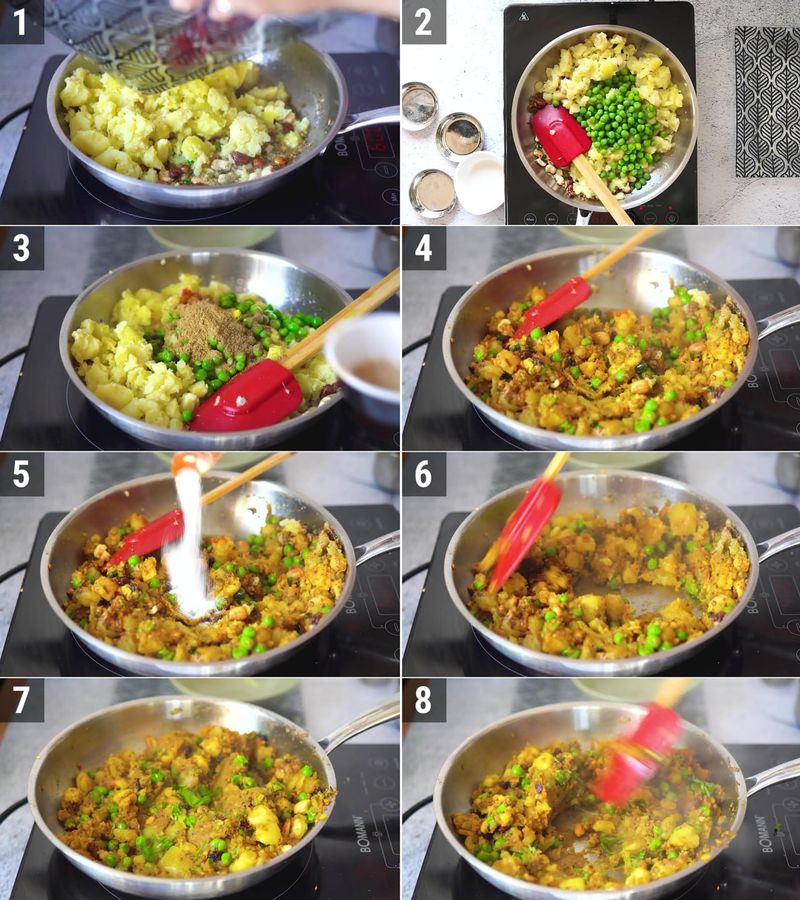
For Deep-Fried Samosas:
- Knead the rested dough again. Then divide the dough into 8 equal-sized portions and roll each portion into a ball. Keep all the balls covered.
- Dip one ball in the oil and roll it out into a thin oval or circle, about 6-7 inches in diameter. Roll out all the balls. Cut each circle in half to form two semi-circles. Now, take one semi-circle, fold it in half to create a cone, and seal the edge using a little water to form a triangular pocket.
- Fill the cone with about 2 tablespoons of prepared potato filling, ensuring it's not overfilled. Apply water to the edge and seal the open edge of the triangle by folding it over and pressing gently to form a triangular-shaped samosa. Follow the same steps to prepare and fill the remaining samosas.
- Heat oil for deep frying in a pan to medium-low heat. Carefully slide in the samosas and fry on low heat for about 12-15 minutes or until they turn golden brown and crispy. Remove the fried samosas from the pan and place them on a paper towel-lined plate to absorb any excess oil. Set them aside and fry the remaining samosas.
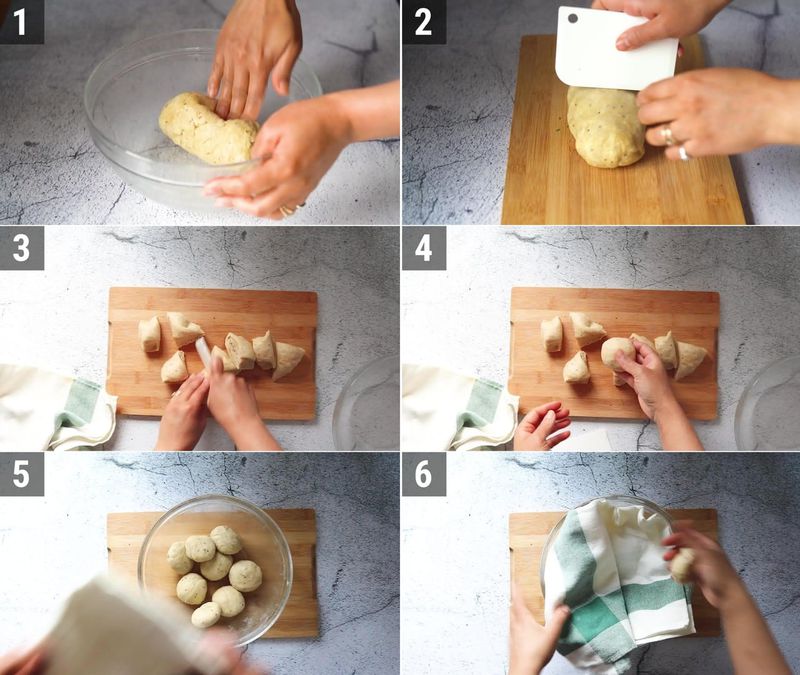
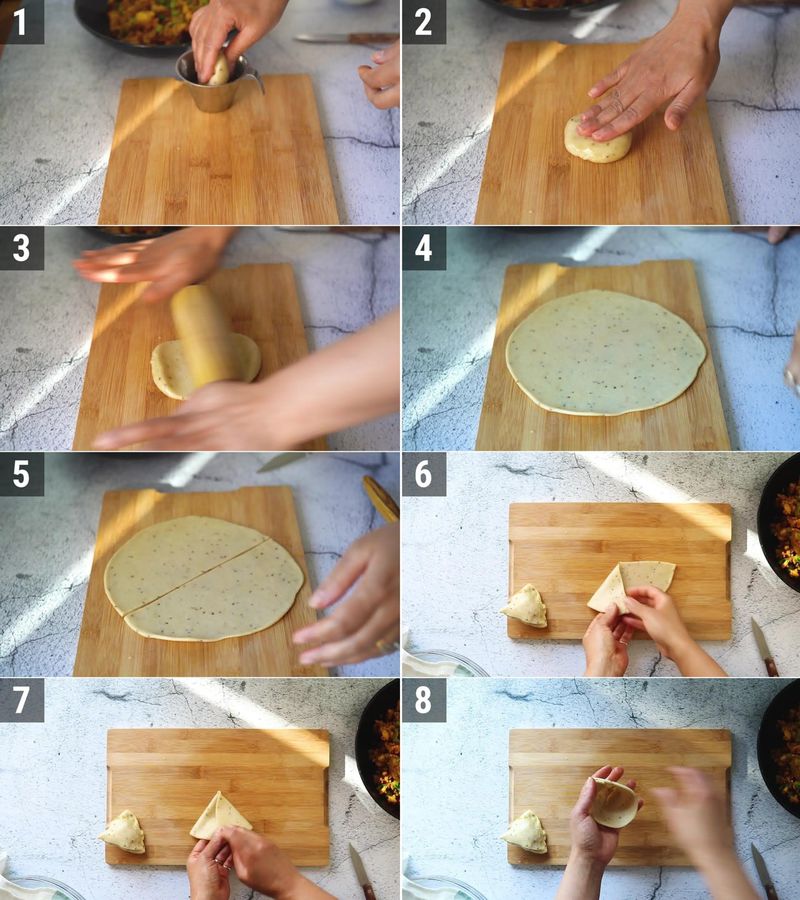
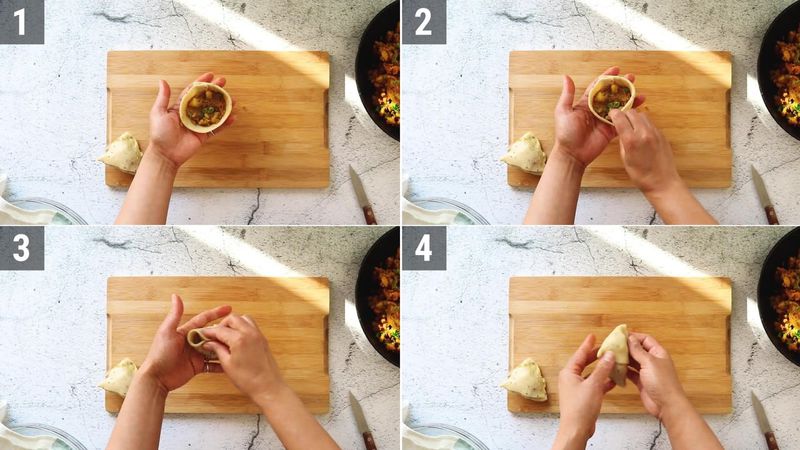
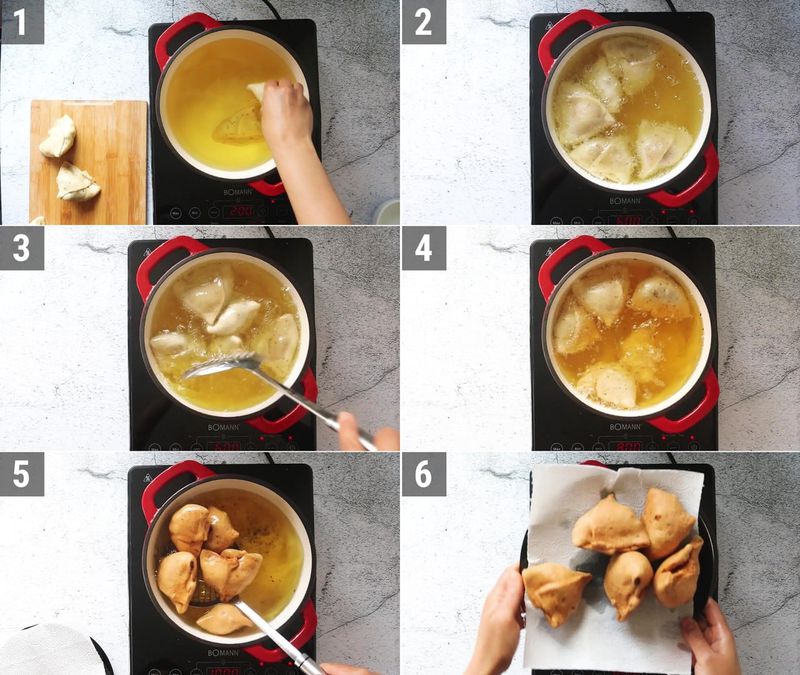
For Air Fryer Samosas:
- Preheat your air fryer to 347°F (175°C). Lightly brush or spray the samosas with oil. Place the samosas in the air fryer basket in a single layer, without overcrowding. Air fry for 10 minutes. Flip the samosas and air-fry for 5 more minutes or until they are golden brown and crispy.
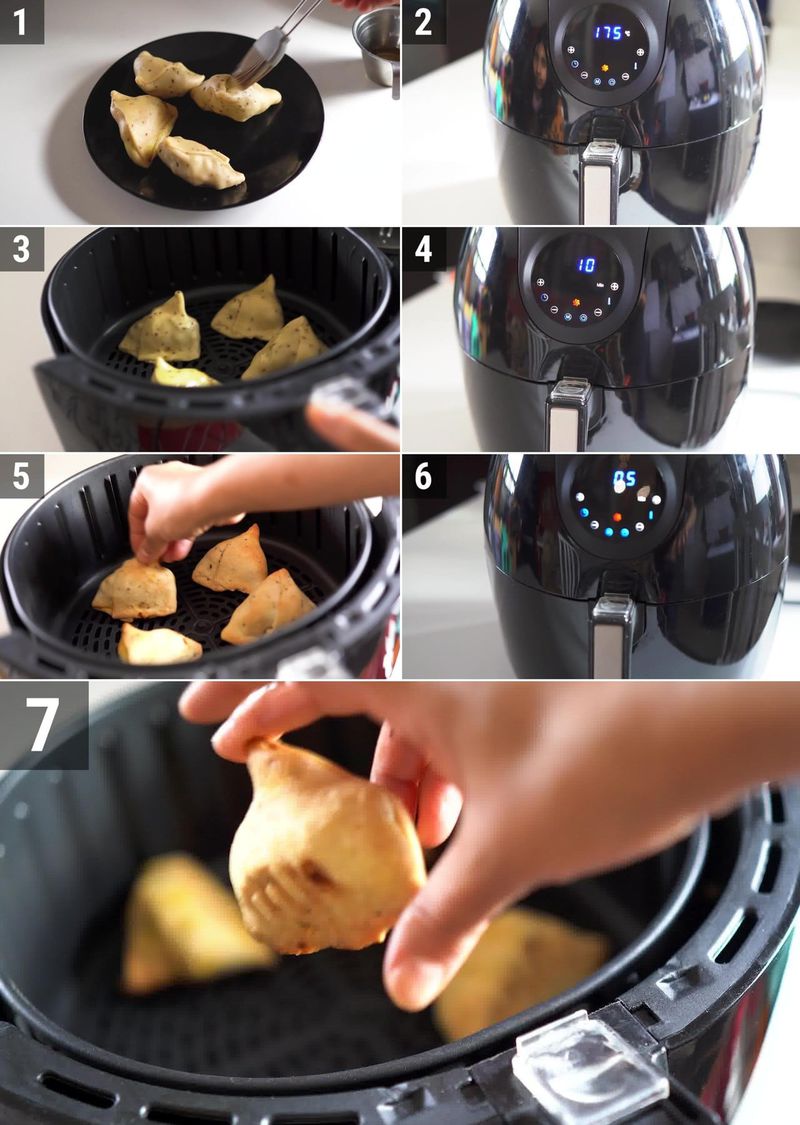
Serving:
- Serve your deep-fried or air-fried samosas hot with your favorite chutney or sauce. Enjoy your homemade samosas!

Recipe Card
Samosa Recipe [Recipe]
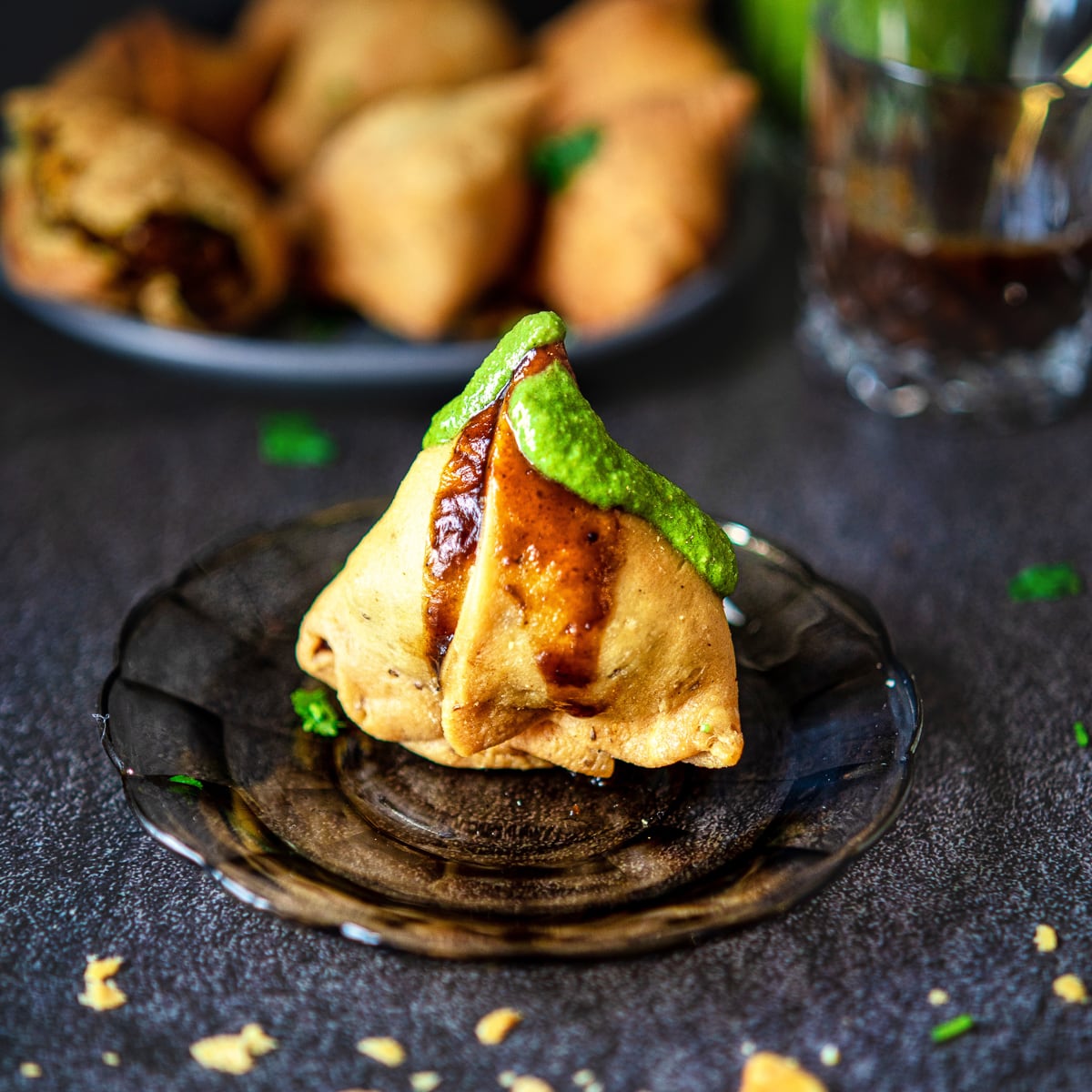
★★★★★
(Rating: 5 from 7 reviews)
| Prep time 🕐 | Cook time 🕐 | Total time 🕐 |
|---|---|---|
| 45 mins | ||
| Category ☶ | Cuisine ♨ | Serves ☺ |
| Snacks | Indian | 16 |
| Nutrition Info ⊛ | Serving size ⊚ | |
| 311 calories | 1 samosa |
INGREDIENTS
For the Samosa Dough
- 2 cups all-purpose flour (maida)
- 1/4 teaspoon salt
- 3/4 teaspoon carom seeds (ajwain)
- 4 tablespoons ghee or oil
- Water (for kneading)
For the Spiced Potato Filling
- 4-5 medium-sized potatoes, boiled and peeled
- 2 tablespoons oil
- 1 teaspoon coarsely pounded coriander seeds
- 1 teaspoon coarsely pounded fennel seeds
- 4-5 cloves, roughly crushed
- 1 teaspoon cumin seeds
- 2 tablespoons chopped cashews
- 1 tablespoon raisins (optional)
- 1-inch piece of ginger, grated
- 2 small green chilies, chopped
- 1/2 cup green peas (fresh or frozen)
- Pinch of asafoetida (hing)
- 1 teaspoon red chili powder, or to taste
- 2 teaspoons coriander powder
- 1/2 teaspoon garam masala powder
- 1 teaspoon amchur (mango powder)
- 1/2 teaspoon turmeric
- Salt to taste
- 1 tablespoon fresh cilantro/coriander leaves, chopped
- Oil for deep frying samosas, plus more for brushing
INSTRUCTIONS:
For the Samosa Dough:
- In a mixing bowl, combine the all-purpose flour, carom seeds (ajwain), salt, and ghee (or oil). Mix the ingredients well until the mixture resembles breadcrumbs. To check, take some flour mixture between your palm and make a fist. If it holds the shape, then you have added enough fat. If the dough falls to pieces, that means you need to add more oil/ghee. Gradually add water and knead the mixture into a firm, smooth dough. Cover it with a cloth and let it rest for 30 minutes.
For the Spiced Potato Filling:
- Using a potato masher, mash the boiled and peeled potatoes. Keep them aside. Heat oil in a pan on medium heat. Add the coarsely pounded coriander seeds, fennel seeds, crushed cloves, cumin seeds chopped cashews, and raisins. Sauté until they turn fragrant and golden brown. Next, add grated ginger and saute for a few seconds. Then add chopped green chilies. Sauté for 30 seconds.
- Add mashed potatoes and peas to the pan. Also, add asafoetida (hing), red chili powder, coriander powder, garam masala, amchur (dried mango powder), and turmeric. Stir to combine, gently pressing the potatoes to help bind the filling. Cook for another 2-3 minutes. Add salt to taste and mix again. Cook for 2 more minutes and add chopped cilantro/coriander leaves. Mix again and remove from heat. Let it cool.
For Deep-Fried Samosas:
- Knead the rested dough again. Then divide the dough into 8 equal-sized portions and roll each portion into a ball. Keep all the balls covered.
- Dip one ball in the oil and roll it out into a thin oval or circle, about 6-7 inches in diameter. Roll out all the balls. Cut each circle in half to form two semi-circles. Now, take one semi-circle, fold it in half to create a cone, and seal the edge using a little water to form a triangular pocket.
- Fill the cone with about 2 tablespoons of prepared potato filling, ensuring it's not overfilled. Apply water to the edge and seal the open edge of the triangle by folding it over and pressing gently to form a triangular-shaped samosa. Follow the same steps to prepare and fill the remaining samosas.
- Heat oil for deep frying in a pan to medium-low heat. Carefully slide in the samosas and fry on low heat for about 12-15 minutes or until they turn golden brown and crispy. Remove the fried samosas from the pan and place them on a paper towel-lined plate to absorb any excess oil. Set them aside and fry the remaining samosas.
For Air Fryer Samosas:
- Preheat your air fryer to 347°F (175°C). Lightly brush or spray the samosas with oil. Place the samosas in the air fryer basket in a single layer, without overcrowding. Air fry for 10 minutes. Flip the samosas and air-fry for 5 more minutes or until they are golden brown and crispy.
Serving:
- Serve your deep-fried or air-fried samosas hot with your favorite chutney or sauce. Enjoy your homemade samosas!
WATCH RECIPE VIDEO: Click the play button and video will load ...
NOTES:
- When making samosas, use enough 'moyan' (ghee or oil) to achieve a flaky crust. A small amount of fat can make the crust hard, so use the recommended amount in this recipe for a crispier texture.
- When shaping samosas, be cautious not to overfill them. Overfilling can lead to difficulty sealing and bursting during frying.
- The dough should have a consistent texture for making samosas. It should neither be too soft nor too hard. You need to strike the right balance of moisture and stiffness in your dough. It should be pliable but not overly soft. If your dough is too soft, add a bit more flour; if it's too hard, add a touch more water while kneading.
- It's especially important to let the dough rest for at least 30 minutes. This step relaxes the gluten, making the dough easier to work with.
